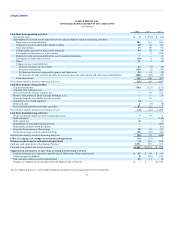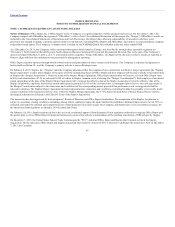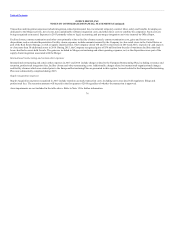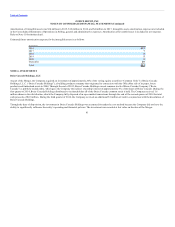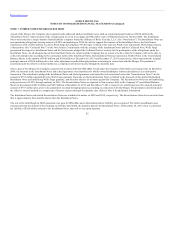OfficeMax 2015 Annual Report Download - page 75
Download and view the complete annual report
Please find page 75 of the 2015 OfficeMax annual report below. You can navigate through the pages in the report by either clicking on the pages listed below, or by using the keyword search tool below to find specific information within the annual report.
Table of Contents
The Company records derivative instruments on the balance sheet at fair value. Changes in the fair value of
derivative instruments are recorded in current income or deferred in accumulated other comprehensive income, depending on whether a derivative is
designated as, and is effective as, a hedge and on the type of hedging transaction. Changes in fair value of derivatives that are designated as cash flow hedges
are deferred in accumulated other comprehensive income until the underlying hedged transactions are recognized in earnings, at which time any deferred
hedging gains or losses are also recorded in earnings. If a derivative instrument is designated as a fair value hedge, changes in the fair value of the instrument
are reported in current earnings and offset the change in fair value of the hedged assets, liabilities or firm commitments. Historically, the Company has not
entered into transactions to hedge its net investment in foreign operations but may in future periods. At December 26, 2015 the fair value of derivative
instruments were not considered material and the Company had no material hedge transactions in 2015, 2014 or 2013.
In May 2014, the Financial Accounting Standards Board (“FASB”) issued an accounting standards update that supersedes most
current revenue recognition guidance and modifies the accounting for certain costs associated with revenue generation. The core principle of this guidance is
that an entity should recognize revenue to depict the transfer of promised goods or services to customers in an amount that reflects the consideration to which
the entity expects to be entitled in exchange for those goods or services. The guidance provides a number of steps to apply to achieve that principle and
requires additional disclosures. The standard was originally to be effective for the Company’s first quarter of 2017. In July 2015, the FASB approved a one
year extension to the required implementation date but also permitted companies to adopt the standard at the original effective date of 2017. Adoption before
the original effective date of 2017 is not permitted. The new revenue standard may be applied retrospectively to each prior period presented or
retrospectively with the cumulative effect recognized as of the date of adoption. The Company is assessing what impacts this new standard will have on its
Consolidated Financial Statements.
On November 5, 2013, the Company completed its merger of equals transaction with OfficeMax. In connection with the Merger, each former share of
OfficeMax common stock, par value $2.50 per share, issued and outstanding immediately prior to the effective time of the Merger was converted to 2.69
shares of Office Depot common stock. The Company issued approximately 240 million shares of Office Depot, Inc. common stock to former holders of
OfficeMax common stock, representing approximately 45% of the approximately 530 million total shares of Company common stock outstanding on the
Merger date. Additionally, OfficeMax employee stock options and restricted stock were converted into mirror awards exercisable or earned in Office Depot,
Inc. common stock. The value of these awards was apportioned between total Merger consideration and unearned compensation and is being recognized over
the remaining original vesting periods of the awards. The consideration transferred in this all stock transaction amounted to approximately $1.4 billion.
Office Depot was determined to be the accounting acquirer. In this all-stock transaction only Office Depot common stock was transferred, the Office Depot
shareholders received approximately 55% of the voting interest of the combined company and other factors were equally shared between the two former
companies, including representation on the combined entity’s Board of Directors, or were further indicators of the Company being the accounting acquirer.
Like Office Depot, OfficeMax was a leader in both business-to-business and retail office products distribution. OfficeMax had operations in the U.S., Canada,
Mexico, Australia, New Zealand, the U.S. Virgin Islands and Puerto Rico. The Merger was intended to create a more efficient global provider of these
products and services that is better able to compete in a changing office supply industry. OfficeMax’s results since the Merger date are included in the
Consolidated Statements of Operations.
73


